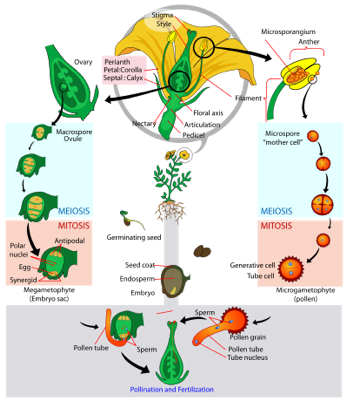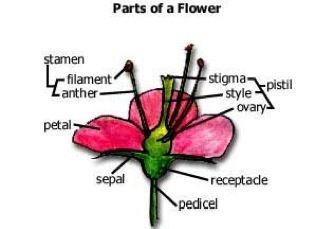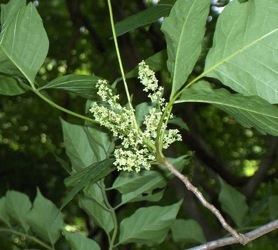Before I get into the steps in Toxicodendron radican’s life cycle there are a couple important aspects I want to introduce. The first one, which is prevalent in all plants, is that the life cycle consists of an alternation of generations. This means that during the plant’s life it alternates between a muticellular diploid sporophyte generation and a mutlicellular haploid gametophyte generation. Since poison ivy is an Angiosperm, the sporophyte generation is dominant and more independent of the gametophyte. For the same reason the gametophyte is smaller and more dependent on the sporophyte. Here are a few other unique aspect seen exclusively in Angiosperms:
Double fertilization: one fertilization juncture produces a zygote and also a trploid cell.
Fruits: A developed ovary that encloses the seeds
Flowers: The reproductive structures in angiosperms
Ovules: protected in the sporophylls instead of exposed on the surface
Now take a look at the steps involved in an angiosperm’s life cycle.
-
1)In the flower’s male parts, the anthers, diploid microsporangium undergo meiosis giving rise to microspores. These haploid microspores will eventually give rise to haploid pollen grains
-
2)In the flower’s ovules, the megasporocyst undergoes meiosis creating four megaspores. Only one of these four megaspores survives and undergoes three mitotic divisions to produce an eight-nucleate embryo sac, or mature megagametophyte
-
3)Next pollination occurs. The pollen grain travels to the stigma via wind, insects or other transportational devices. Once on the stigma it generates a pollen tube down the style.
-
4)Two sperm travel down each pollen tube into the ovary. One sperms fertilizes the egg to produce a zygote and the other fertilizes the central cell to form the endospore.
-
5)The zygote will give rise to an embryo and will be enclosed with the endospore in a seed. The endospore gives the embryo energy to germinate.
-
6)Poison ivy’s seeds are typically dispersed by animals. However the seeds are buoyant which makes dispersal by water possible as well.
-
7)Once the seed does germinate, the diploid zygote will eventually turn into another sporophyte. This process is about three years in poison ivy
-
8)The cycle starts over.






